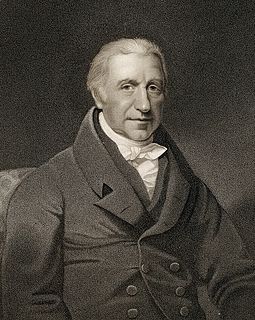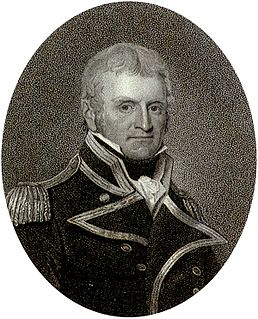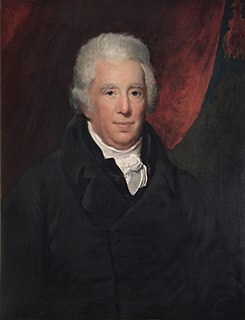
Earl Howe is a title that has been created twice in British history, for members of the Howe and Curzon-Howe family respectively. The first creation, in the Peerage of Great Britain, was in 1788 for Richard Howe, but became extinct on his death in 1799. The second creation, in the Peerage of the United Kingdom was in 1821 for Richard Curzon, and remains extant.

William Babington FRS FGS was an Anglo-Irish physician and mineralogist.
Admiral Vere Beauclerk, 1st Baron Vere, known as Lord Vere Beauclerk until 1750, was a Royal Navy officer, British peer and politician who sat in the House of Commons for 24 years from 1726 to 1750. After serving various ships in the Mediterranean and then commanding the third-rate HMS Hampton Court, he joined the Board of Admiralty, ultimately serving as Senior Naval Lord.

The Sick and Hurt Commissioners were responsible for medical services in the Royal Navy. They were a separate body to the Navy Board, supplying surgeons to naval ships, providing them with medicines and equipment, and running shore and ship hospitals; they were also responsible for prisoners of war.

John Shortland (1769–1810) was a naval officer, the eldest son of John Shortland. Shortland joined the Royal Navy as a midshipman and went to Quebec in a transport commanded by his father. From 1783 to 1787 he served in the West Indies. In 1787 he was master's mate in the Sirius when the First Fleet sailed for Australia. Shortland spent nearly five years in Australia including time on Norfolk Island where Sirius was wrecked in 1790. In 1792 he returned to England.

HMS Suffolk was a 74-gun third-rate ship of the line of the Royal Navy, launched on 22 February 1765 at Rotherhithe. She was designed by William Bateley, based on the principles of his earlier HMS Fame, and was the only ship built to her draught.

James Carmichael Smyth FRS FRCP was a Scottish physician and medical writer.

Charles George Perceval, 2nd Baron Arden PC FRS was a British politician.

During the eighteenth and nineteenth centuries the Royal Navy made use of a considerable number of hired armed vessels. These were generally smaller vessels, often cutters and luggers, that the Navy used for duties ranging from carrying despatches and passengers to convoy escort, particularly in British coastal waters, and reconnaissance.

Sir George Grey, 1st Baronet, was a British Royal Navy officer and a scion of the noble House of Grey. He served with the Royal Navy from the age of 14 and was on active service from 1781 to 1804, during the latter years of the American War of Independence, the French Revolutionary War and the Napoleonic War.

The Lord High Admiral is the ceremonial head of the Royal Navy. Most have been courtiers or members of British royal family, and not professional naval officers. The office of Lord High Admiral is one of the nine English Great Officers of State.
The New Year Honours 1922 were appointments by King George V to various orders and honours to reward and highlight good works by members of the British Empire. They were published on 30 December 1921.
The 1896 Birthday Honours were appointments by Queen Victoria to various orders and honours to reward and highlight good works by citizens of the British Empire. The appointments were made to celebrate the official birthday of The Queen, and were published in The London Gazette on 20 May and 26 May and in The Times on 20 May 1896.
The 1920 Birthday Honours were appointments by King George V to various orders and honours to reward and highlight good works by citizens of the British Empire. The appointments were made to celebrate the official birthday of The King, and were published in The London Gazette on 4 June 1920.

During the early 17th century, England's relative naval power deteriorated, In the course of the rest of the 17th century, The office of the Admiralty and Marine Affairs steered the Navy's transition from a semi-amateur Navy Royal fighting in conjunction with private vessels into a fully professional institution, a Royal Navy. Its financial provisions were gradually regularised, it came to rely on dedicated warships only, and it developed a professional officer corps with a defined career structure, superseding an earlier mix of sailors and socially prominent former soldiers.

The Glorious Revolution of 1688 rearranged the political map of Europe, and led to a series of wars with France that lasted well over a century. This was the classic age of sail; while the ships themselves evolved in only minor ways, technique and tactics were honed to a high degree, and the battles of the Napoleonic Wars entailed feats that would have been impossible for the fleets of the 17th century. Because of parliamentary opposition, James II fled the country. The landing of William III and the Glorious Revolution itself was a gigantic effort involving 100 warships and 400 transports carrying 11,000 infantry and 4,000 horses. It was not opposed by the English or Scottish fleets.

The Civil Lord of the Admiralty formally known as the Office of the Civil Lord of Admiralty also referred to as the Department of the Civil Lord of the Admiralty was a member of the Board of Admiralty who was responsible for managing the Royal Navy's supporting civilian staff, the works and buildings departments and naval lands from 1830 to 1964.

The Deputy Comptroller of the Navy was a principal member of the Navy Board of the Royal Navy who was responsible for chairing the Committee of Correspondence and managing all internal and external communications of the Navy Board from 1793 to 1816 and then again from 1829 to 1832. He was based at the Navy Office.
John Johnstone (1768–1836) was a British physician and biographer.















